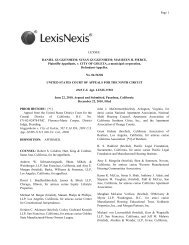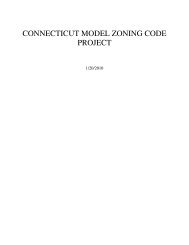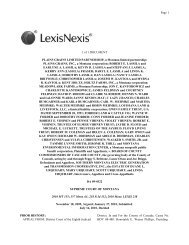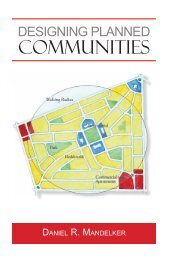Through a Glass Darkly: Measuring Loss Under ... - Land Use Law
Through a Glass Darkly: Measuring Loss Under ... - Land Use Law
Through a Glass Darkly: Measuring Loss Under ... - Land Use Law
Create successful ePaper yourself
Turn your PDF publications into a flip-book with our unique Google optimized e-Paper software.
MEASURING LOSS UNDER MEASURE 37 577<br />
regulations. Each of these valuation methods is analyzed against the<br />
criterion of the accuracy of that method in quantifying the loss caused<br />
by the land use regulation in question.<br />
A. The Exemption Method<br />
The majority of applications under Measure 37 employ the so-called<br />
“exemption method” to quantify the loss in value of their properties<br />
resulting from the “enactment or enforcement” of the land use regulation.<br />
While it has not been advocated in any academic literature, the<br />
exemption method is also currently accepted by most local governments<br />
as a valid means of loss quantification. 59 The attraction of this method<br />
lies both in its simplicity, and, from the claimant’s viewpoint, its propensity<br />
to result in high loss estimates. As Professors Jaeger and Plantinga<br />
explain, the method assumes that:<br />
“[J]ust compensation” under Measure 37—that is, a government making up for the<br />
reduction in value of a property resulting from a land-use regulation—is equal to the<br />
increase in value if the regulation is waived for that property alone. 60<br />
The Measure 37 claim made in the City of Portland by Augustine and<br />
Lorraine Calcagno serves as a valuable illustration of how the exemption<br />
method works. 61 The Calcagnos owned two parcels of land, totaling<br />
19,400 square feet. A single residential dwelling was situated on each<br />
parcel. The property was rezoned sometime after their purchase, effectively<br />
reducing the number of units which could potentially be developed<br />
on the site by two-thirds. 62 According to the authors of a report<br />
documenting their claim, the Calcagnos claimed “that land use regulations<br />
have decreased the value of their North Portland property by<br />
59. Libby Tucker, A Method in the Madness, DAILY J. OF COM., July 13, 2006, available<br />
at http://www.friends.org/issues/M37/documents/M37-DJC-2006-07-13.pdf.<br />
60. See W.K. Jaeger & A.J. Plantinga, The Economics Behind Measure 37, EM 8925<br />
OR. STATE UNIV. EXTENSION SERV. 1–4 (2007), available at http://extension.oregonstate.<br />
edu/ catalog/pdf/em/em8925.pdf.<br />
61. See SHEILA A. MARTIN & KATIE SHRIVER, DOCUMENTING THE IMPACT OF MEASURE<br />
37: SELECTED CASE STUDIES (2006) [hereinafter MARTIN & SHRIVER]. The Calcagno<br />
claim is the basis of Case Study 2: The Role of Community Planning in North Portland.<br />
Id. at 22. Their compensation claim is considerably smaller than the majority of<br />
other claimants in the remaining nine case studies. The Calcagnos claimed $500,000<br />
in loss, while the average public payment claimed over the ten claims nears the<br />
$3 million mark. Id.<br />
62. In re Calcagno, Ballot Measure 37 Claim for Compensation (OR. REV. STAT.<br />
§ 197) Staff Report and Recommendations, Claim No. 05-117098 PR (Aug. 12, 2005)<br />
[hereinafter Calcagno Staff Report], available at http://www.portlandonline.com/shared/<br />
cfm/image.cfmid 96464.<br />
ABA-TUL-07-0701-Sullivan.indd 577<br />
9/18/07 10:43:39 AM







